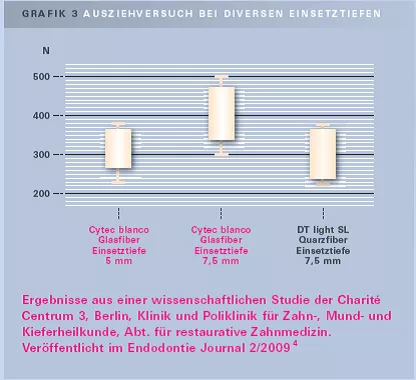Root post systems
Our root posts are your basis for a permanently stable root post build-up, because we take great care in selecting material with the highest bending strength and fatigue resistance.
| Cytec | Contec | Exatec | |
|---|---|---|---|
| Material | HT glass fiber (High Tenacity) | HT Glass Fiber (High Tenacity) | HT Glass Fiber (High Tenacity) Titanium |
| Shape of the root posts | Cylindrical + conical | Conical, double cone | with post head, conical in the apical part |
| Shape of the body part | Cylindrical | ||
| Surface design | Micro-retentive | Micro-retentive | Micro-retentive |
| Quantity diameters | 6 | 5 | 4 |
| post diameter | 1.0 mm | 1,1 mm | Size 1*) |
| 1,2 mm | 1.3 mm | Size 2*) | |
| 1,4 mm | 1,5 mm | Size 3 | |
| 1.6 mm | 1.75 mm | Size 4 | |
| 1,8 mm | 2.0 mm | ||
| 2.1 mm | |||
| Lengths | 20 mm | 20 mm | 20 mm |
| Titanium: 12/15/18/20 mm | |||
| Applications | for rather cylindrical roots | For rather conical roots | for teeth with high coronal damage |
*) Size 1 and size 2 cover 99% of all restorations according to practical experience.
Material
| Titanium | HT-Glassfiber | |
|---|---|---|
| Exatec Titanium & Exatec-S Titanium | Exatec blanco, Cytec & Contec | |
| Color | Metal colors | white, semi-translucent |
| E-modulus | High stiffness → increased risk of root fractures | Low stiffness → better distribution of masticatory forces |
| Adhesion/ Connectivity | retentive surface profile | microretentive network structure very good, pull-out force up to 486 N (Charité Berlin, Endodontie Journal 2/2009) |
| Market launch | 1985 | 2001 |
Scientific references
E-modulus
Elastizität in comparison:
Titanium: high stiffness ⇒ increased risk of root fractures
HT glass fiber: low stiffness ⇒ better distribution of masticatory forces
Flexural strength
| Product name | material | Diameter | Flexural strength - median of 5 pins |
|---|---|---|---|
| mm | MPa | ||
| HAHNENKRATT - Cytec blanco | HT glass fiber | 1,5 | 1.282,61 |
| VDW DT Light Post | Quartz fiber | 1,5 | 1.123,01 |
| Waistfer Easypost | Glass fiber | 1,37 | 652,75 |
| Comet ER Dentine Post | Glass fiber | 1,33 | 801,59 |
| Para Post Fiber white | Glass fiber | 1,4 | 923,48 |
| Ivoclar FRC Postec | Glass fiber | 1,48 | 1.006,40 |
Flexural strength tests were performed in accordance with DIN 53 390: Flexural Test on Unidirectional
glass fiber reinforced round bar laminates was carried out by the IVW Institute of the University of Kaiserslautern .
Adhesion
| 486.1 N - Cytec blanco | 1.8 mm, 10 mm insertion depth, adhesively cemented with Panavia F |
|---|---|
| 335.6 N - VDW DT Light SL | 1.8 mm, 10 mm insertion depth, with VDW recommended comp. fastened |
| 378.0 N - VDW DT Light SL | Pull-out force according to VDW information |

Taking into account the clinical conditions and the indication, it must be remembered that there are limits to the fracture and bending strength of a prefabricated root post,- due to the material and the selected post diameter. But other components, for example remaining tooth structure or abutment and crown, are also decisive for the success of a restoration. Carefully grinding in a balanced occlusion is crucial for the stability of the restoration and its service life. The dynamic loading by the antagonists must be as low as possible. Incorrect or excessive loading can cause restorations to loosen, shift orthodontically or even fracture.
All information and studies are summarized in our brochure.
FAQ's
All dual-curing, thin-flowing composites bond very well with the glass fiber of the posts, e.g. Panavia F, Rely X (other examples in the brief instructions).
No, the post surface is micro-retentively prepared in such a way that very good bonding with a dual-curing composite is ensured.
See brochure page 8-Cytec blanco achieves very high retention values in comparative pull-out tests at the Charité in Berlin, which are even
via
values of DT light SL root postsfrom VDW, which advertise the SL – Safety Lock layer.
Exatec root posts with the post head are particularly suitable for teeth with large coronal defects.
Cytec root posts canal root posts – with the cylindrical-conical course – are suitable for root canals that have a rather cylindrical course and only taper towards the apical end. The Cytec root posts retain – due to the cylindrical shape – the stronger diameter over a longer range. In principle, a stronger diameter also results in a higher breaking strength.
Contec root posts canal root posts – with the double conical course – are suitable for root canals that have a rather conical course. In order to optimize the preservation of the tooth structure, a Contec should be used for such root canals.
Double conical, as the cone angle is larger at first and smaller towards the apical tip. An overview is attached.
See also the picture of the root posts on our brochure, you can see very well the difference between cylindrical/conical and biconical.
